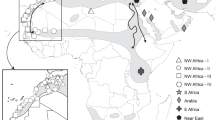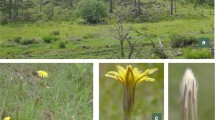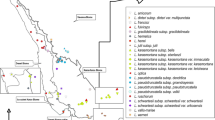Abstract
Tunisian hares (n = 45), currently assigned to Lepus capensis, were assayed for allelic variation at 40 allozyme loci, and allele frequencies at 32 loci were directly compared with earlier data of South African cape hares (L. capensis, n = 9) and European brown hares (L. europaeus, n = 244) to reveal genetic relationships among them. European mountain hares (L. timidus, n = 200) were used for outgroup comparison. In the Tunisian hares 27.5% of the loci were polymorphic with 2–4 alleles. Among all alleles at polymorphic loci, 15.1% occurred exclusively in Tunisian hares, 5.7% exclusively in cape hares, and 7.5% exclusively in brown hares at low frequencies. Not a single locus showed alternately fixed alleles between the samples of the L. capensis/L. europaeus complex. Levels of absolute and relative genetic differentiation among the samples of the L. capensis/ L. europaeus complex were low, relative to pairwise comparisons involving mountain hares. Diverse cluster analyses and multidimensional scaling of various pairwise genetic distance matrices concordantly grouped Tunisian hares with brown hares, and South African cape hares clustered only slightly farther apart, whereas mountain hares were distinctly separate. These results suggest regionally distinct phylogenetic units within an overall cohesive gene pool in the L. capensis/ L. europaeus complex, supporting Petter's view that all North African hares belong to L. capensis except for one local population of savanna hares, and that cape hares and brown hares are conspecific.
Similar content being viewed by others
References
Alves, P. C., and Ferrand, N. (1999). Genetic variability in Portugese populations of the Iberian hare, Lepus granatensis. Folia Zool. 48 (Suppl. 1):3–10.
Alves, P. C., Branco, M., Matias, O., and Ferrand, N. (2000). New genetic variation in the European hares, Lepus granatensis and L. europaeus. Biochem. Genet. 38:87–96.
Alves, P. C., Ferrand, N., and Suchentrunk, F. (2001). Developmental stability and protein heterozygosity in a local population of Iberian hares (Lepus granatensis). Mamm. Biol. 66: 238–250.
Alves, P. C., Ferrand, N., Suchentrunk, F., and Harris, D. J. (2003). Ancient introgression of Lepus timidus mtDNA into L. granatensis and L. europaeus in the Iberian Peninsula. Mol. Phylogent. Evol. 27:70–80.
Angermann, R. (1965). Revision der palaearktischen und äthiopischen Arten der Gattung Lepus (Leporidae, Lagomorpha). Diss. Thesis. Humboldt University of Berlin, pp. 200.
Angermann, R. (1983). The taxononmy of Old World Lepus. Acta Zool. Fennica 174:17–21.
Averianov, A. O., and Baryschnikov, G. F. (1992). Pleistocene hares (genus Lepus, Lagomorpha) of the Great Caucasus. Trudy Zool. Inst. RAN 246:4–28.
Averianov, A., Niethammer, J., and Pegel, M. (2003). Lepus europaeus Pallas, 1778 –Feldhase. In Krapp, F. (ed.), Handbuch der Säugetiere Europas: Hasentiere, Aula-Verlag, Wiebelsheim, Germany, pp. 35–104.
Avise, J. C. (1994). Molecular Markers, Natural History and Evolution, Chapman and Hall, New York, London, pp. 511.
Belkhir, K. (1999). GENETIX, logiciel sous Windows pour la génétique des populations. Laboratoire Génome et Populations, CNRS UPR 9060, Université de Montpellier II, Montpellier (France).
Bonhomme, F., Fernandez, J., Palacios, F., Catalan, J., and Machordon, A. (1986). Charactérisation biochimique du complex d'espèces du genre Lepus en Espagne. Mammalia 50:495–506.
Eggert, L. S., Rasner, C. A., and Woodruff, D. S. (2002). The evolution and phylogeography of the African elephant inferred from mitochondrial DNA sequence and nuclear microsatellite markers. Proc. R. Soc. Lond. B 269:1993–2006.
Ellerman, J. R., and Morrison Scott, T. C. S. (1951). Checklist of Palaearctic and Indian Mammals, British Museum of Natural History, London.
Felsenstein, J. (1995). PHYLIP (Phylogeny Inference Package), Version 3.57c. Seattle: University of Washington.
Flux, J. E. C., and Angermann, R. (1990). Hares ab Jackrabbits. In Chapman, J. A., and Flux, J. E. C. (eds.), Hares and Pikas: Status Survey and Conservation Action Plan, IUCN/SSC Lagomorph Specialist Group, Gland, Switzerland, pp. 61–94.
Goudet, J. (1995). Fstat Version 1.2. A computer program to calculate F-statistics. J. Heredity 86:485–486.
Goudet, J. (2001). Fstat, a program to estimate and test gene diversities and fixation indices (version 2.9.3). Available from http://www.unil.ch/izea/softwares/fstat.html. Updated from Goudet (1995).
Grillitsch, M., Hartl, G. B., Suchentrunk, F., and Willing, R. (1992). Allozyme evolution and the molecular clock in the Lagomorpha. Acta Theriol. 37:1–13.
Halanych, K. M., Demboski, J. R., van Vuuren, J. B., Klein, D. R., and Cook, J. A. (1999). Cytochrome b phylogeny of North American hares and jackrabbits (Lepus, Lagomorpha) and the effects of saturation in outgroup taxa. Mol. Phylogenet. Evol. 11:213–221.
Harris, H., and Hopkinson, D. A. (1976). Handbook of Enzyme Electrophoresis in Human Genetics, North-Holland Publ. Co, Amsterdam.
Hartl, G. B., and Höger, H. (1986). Biochemical variation in purebred and crossbred strains of domestic rabbit Oryctolagus cuniculus L. Genet. Res. (Camb.) 48:27–34.
Hartl, G. B., Markowski, J., Kovacs, G., Grillitsch, M., and Willing, R. (1990). Biochemical variation and differentiation in the brown hare (Lepus europaeus) of Central Europe. Z. Säugetierkunde 55:186–193.
Hartl, G. B., Markowski, J., Swiatecki, A., Janiszewski, T., and Willing, R. (1992). Genetic diversity in the Polish brown hare Lepus europaeus Pallas, 1778: Implications for conservation and management. Acta Theriol. 37:15–25.
Hartl, G. B., Suchentrunk, F., Nadlinger, K., and Willing, R. (1993). An integrative analysis of genetic differentiation in the brown hare Lepus europaeus based on morphology, allozymes, and mitochondrial DNA. Acta Theriol. 38 (suppl. 2):33–57.
Hartl, G. B., Willing, R., and Nadlinger, K. (1994). Allozymes in mammalian population genetics and systematics: Indicative function of a marker system reconsidered. In Schierwater, B., Streit, B., Wagner, G. P., and DeSalle, R. (eds), Molecular Ecology and Evolution: Approaches and Applications, Birkhäuser Verlag, Basel, Switzerland, pp. 299–310.
Kasapidis, P., Suchentrunk, F., Magoulas, A., and Kotoulas, G. (2005). The shaping of mitochondrial DNA phylogeographic patterns of the brown hare (Lepus europaeus) under the combined influence of Late Pleistocene climatic fluctuations and anthropogenic translocations. Mol. Phylogenet. Evol. 34:55–66.
Kretzoi, M. (1941). Die unterpleistozäne Säugetierfauna von Betfia bei Nagyvárad. Földt. Közl. 71:308–335.
Kryger, U., Robinson, T. J., and Bloomer, P. (2002). Isolation and characterization of six polymorphic microsatellite loci in South African hares (Lepus saxatilis F. Cuvier, 1823, and Lepus capensis Linnaeus, 1758). Mol. Ecol. Notes 2:422–424.
Li, W. H. (1997). Molecular Evolution. Sinauer Assoc., Sunderland, Mass., pp. 487.
Lu, X. (2000). Body weights of the cape hare Lepus capensis in northern China. Acta Theriol. 45:271–280.
Mamuris, Z., Sfougaris, A. I., and Stamatis, C. (2001). Genetic structure of Greek brown hares (Lepus europaeus) as revealed by mtDBNA RFLP-PCR analysis: Implications for conserving genetic diversity. Biol. Conserv. 101:187–196.
Mamuris, Z., Sfougaris, A. I., Stamatis, C., and Suchentrunk, F. (2002). Assessment of genetic structure of Greek brown hare (Lepus europaeus) populations based on variation in random amplified polymorphic DNA (RAPD). Biochem. Genet. 40:323–338.
Mils, G., and Hes, L. (1999). Säugetiere des südlichen Afrika: Eine illustrierte Enzyklopädie, Könemann Publisher, Köln, Germany, pp. 356.
Nei, M. (1978). Estimation of average heterozygosity and genetic distance from a small number of individuals. Genetics 89:583–590.
Petter, F. (1959). Eléments d'une révision des lièvres africains du sous-genre Lepus. Mammalia 23:41–67.
Petter, F. (1961). Eléments d'une révision des lièvres européens et asiatiques du sous-genre Lepus. Z. Säugetierkunde 26:1–11.
Pielowski, Z. (1969). Sex ratio and weight of hares from Poland. Acta Theriol. 14:119–131.
Pierpaoli, M., Riga, F., Trocchi, V., and Randi, E. (1999). Species distinction and evolutionary relationships of the Italian hare (Lepus corsicanus) as described by mitochondrial DNA sequencing. Mol. Ecol. 8:1805–1817.
Rekovets, L. I. (1985). Mikrotheriofauna desnyansko-podneprovskogo posdnego paleolita. Naukova Dumka, Kiev, Belarus, pp. 168.
Rice, W. S. (1989). Analyzing tables of statistical tests. Evolution 43:223–225.
Richardson, B. J., Baverstock, P. R., and Adams, M. (1986). Allozyme electrophoresis. A Handbook for animal systematics and populaiton studies. Academic Press, San Diego, pp. 410.
Rothe, G. M. (1994). Electrophoresis of Enzymes: Laboratory Methods, Springer Lab Manual. Springer Verlag, Berlin, pp. 307.
Sert, H., Suchentrunk, F., and Erdogan, A. (2005). Genetic diversity in brown hares (Lepus europaeus Pallas, 1778) from Anatolia and differentiation among Anatolian and European populations. Mamm. Biol. 70:171–186.
Suchentrunk, F., Hartl, G. B., Flux, J. E. C., Parkes, J., Haiden, A., and Tapper, S. (1998). Allozyme heterozygosity and fluctuating asymmetry in brown hares Lepus europaeus introduced to New Zealand: Developmental homeostasis in populations with a bottleneck history. Acta Theriol., Suppl. 5:35–52.
Suchentrunk, F., Polster, K., Giacometti, M., Ratti, P., Thulin, C.-G., Ruhlé, C., Vasil'ev, A. G., and Slotta-Bachmayr, L. (1999). Spatial partitioning of allozyme variability in European mountain hares (Lepus timidus): Gene pool divergence across a disjunct distributional range? Z. Säugetierkunde 64:1–11.
Suchentrunk, F., Michailov, C., Markov, G., and Haiden, A. (2000a). Population genetics of Bulgarian brown hares Lepus europaeus: Allozymic diversity at zoogeographical crossroads. Acta Theriol. 45:1–12.
Suchentrunk, F., Alkon, P. U., Willing, R., and Yom-Tov, Y. (2000b). Epigenetic dental variability of Israeli hares (Lepus sp.): Ecogenetic or phylogenetic causation? J. Zool. (London) 252:503–515.
Suchentrunk, F., Jaschke, C., and Haiden, A. (2001). Little allozyme and mtDNA variability in brown hares (Lepus europaeus) from New Zealand and Britain: A legacy of bottlenecks? Mamm. Biol. 66:48–59.
Suchentrunk, F., Mamuris, Z., Sfougaris, A. I., and Stamatis, C. (2003). Biochemical genetic variability in brown hares (Lepus europaeus) from Greece. Biochem. Genet. 41:127–140.
Suchentrunk, F., Mamuris, Z., Stamatis, C., Kryger, U., and Alkon, P. U. (in press): Skull shape and molecular differentiation among brown hares (L. europaeus), cape hares (Lepus capensis) and hares from Israel, a presumed contact zone of these two species. Biol. J. Linn. Soc.
Swofford, D. L.; and Selander, R. B. (1989). BIOSYS-1: A computer program for the analysis of allelic variation in population genetics and biochemical systematics. Release 1.7. Users manual. Illinois Natural History Survey, Champaign.
Sych, L. (1965). Fossil Leporidae from the Pliocene and Pleistocene of Poland. Acta Zool. Cracov. 10:1–83.
Thulin, C.-G., Jaarola, M., and Tegelström, H. (1997). The occurrence of mountain hare mitochondrial DNA in wild brown hares. Mol. Ecol. 6:463–467.
Vapa, L., Obreht, D., Vapa, M., and Selmic, V. (2002). Genetic variability in brown hare (Lepus europaeus) populations in Yugoslavia. Z. Jagdwiss. 48 (Suppl.):261–266.
Vapa, L., Davidovic, M., Obreht, D., Hammer, S., and Suchentrunk, F. (in press). Allozyme variability of brown hares (Lepus europaeus) from the Vojvodina region (Serbia and Montenegro), compared to central and southeastern European populations. Acta Zool. Acad. Sci. Hung.
Vigne, J. D. (1992). Zooarchaeology and the biogeographical history of the mammals of Corsica and Sardinia since the last ice age. Mammal Rev. 2:87–89.
Weir, B. S., and Cockerham, C. C. (1984). Estimating F-statistics for the analysis of population structure. Evolution 38:1358–1370.
Wilson, D. E., and Reeder, D. A. M. (eds.) (1993). Mammal Species of the World: A Taxonomic and Geographic Reference, 2nd edn., Smithsonian Institution Press, Washington, DC, 1207 pp.
Wright, S. (1978). Evolution and Genetics of Populations, 4: Variability within and among natural populations. University of Chicago Press, Chicago, 580 pp.
Author information
Authors and Affiliations
Corresponding author
Rights and permissions
About this article
Cite this article
Slimen, H.B., Suchentrunk, F., Memmi, A. et al. Biochemical Genetic Relationships Among Tunisian Hares (Lepus sp.), South African Cape Hares (L. capensis), and European Brown Hares (L. europaeus). Biochem Genet 43, 577–596 (2005). https://doi.org/10.1007/s10528-005-9115-6
Received:
Accepted:
Issue Date:
DOI: https://doi.org/10.1007/s10528-005-9115-6




